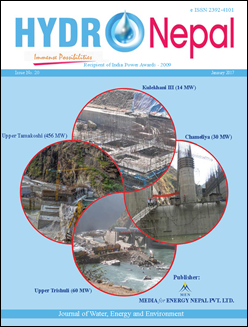An Environmentally Friendly Integrated Development Approach for Nepal (Experiences from Irrigation Sector Projects)
DOI:
https://doi.org/10.3126/hn.v20i0.16486Keywords:
Irrigation project Environmentally Friendly, Irrigated Development Approach, Sustainable DevelopmentAbstract
Nepal has distinctly three ecological regions: (i) high mountain, (ii) mid-hills, and (iii) terai with their varying climatic and physiographic features. The experiences gathered from Irrigation Sector Projects implemented under various donor agencies such as the World Bank (WB), Asian Development Bank (ADB), and UN/ILO have shown that successful irrigation projects must be defined and planned according to specific ecological regions and pertinent to the local environment. An integrated development approach considers the land use, roads, market, and other economic activities as they relate to prospects for poverty alleviation. Land evaluation and subsequent land use planning according to the soil, climate, land profile, and suitability of agriculture practices should be considered in the development works to ensure true benefit to the rural populations. The integrated approach as such will provide long term sustainability through environmentally sound practices. This approach has been widely applied in the European countries, Korea, Japan, and Sri Lanka.
This paper primarily focuses on the irrigation and development approaches most suitable to Nepal’s three ecological regions. High mountain regions should be developed with pasture land, horticulture, organic vegetable farming, and tourism. Irrigation technology in these areas should be simple pipe conveyance, and tank irrigation. In the mid-hills horticulture on the sloping terrain and cereal crops in the river valleys with other diversified cropping systems should be applied. The Terai region is the ‘Bread Basket’ of Nepal, and has high potential for diversified agriculture and industrial development.
For development in these regions to succeed, road networks and transportation facilities are essential to economic growth. Road transportation maximizes opportunity for tourism and other economic activities. Development work must be planned in an integrated approach, which should be based on appropriate land use patterns for environmentally sustainable practices. An ideal solution would be to envision the watershed as the unit for eco-friendly sustainable development planning involving all the stakeholders under the watershed purview. As an example, the principles of Integrated Water Resources Management Planning (IWRMP), and Integrated Watershed Management Plan (IWMP) have been successfully applied in the USA and Australia (Box 1). It has illustrated that vegetative covered catchment stores large amount of rain water, increases groundwater table, reduces erosion of soil, and lastly decreases the intensity of flood hazard. Whereas, the naked catchment areas are highly erodible, does not store rain water, susceptible to high erosion and landslides, and increases the flood intensity by three fold than a vegetative covered one. The vegetative cover increases the water resources availability for over all development for agriculture.
HYDRO Nepal Journal
Journal of Water Energy and Environment
Issue: 20
Page: 31-40
Downloads
Downloads
Published
How to Cite
Issue
Section
License
The copyright of the articles and papers published is held by HYDRO Nepal Journal.
The views and interpretation in this journal are those of author(s), and HYDRO Nepal does not bear any responsibility for the views expressed by authors in the journal.




